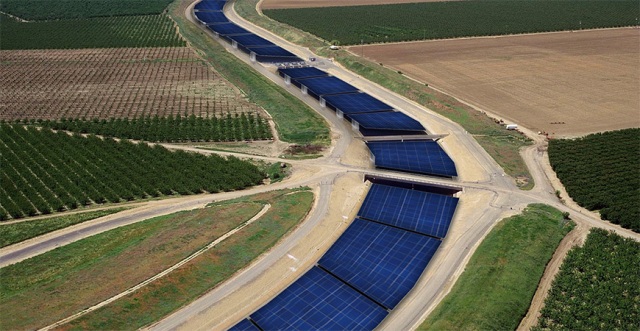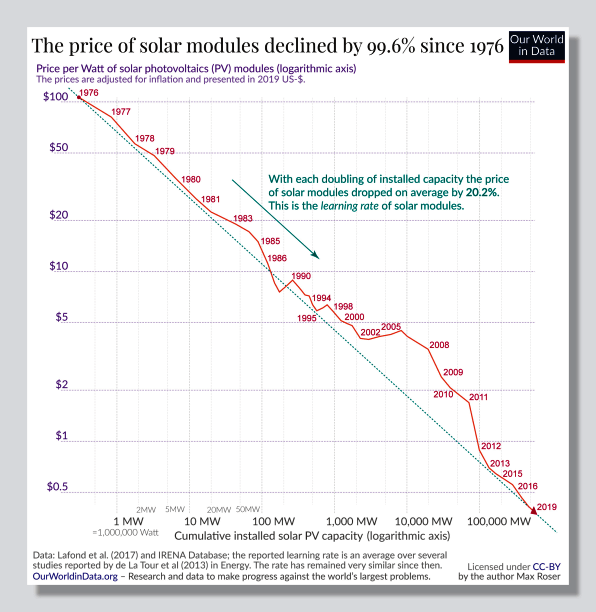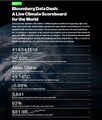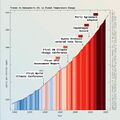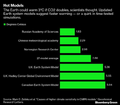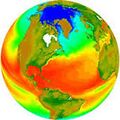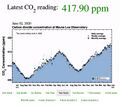Category:Solar Energy
<addthis />
Solar Power News
- Solar Power, Sun Powered
Record-breaking solar-over-water production farm announced
July 22, 2021
Plans were unveiled today for the world’s largest floating solar power and energy storage system. At a cost estimated at $2 billion, the system will be developed by Singapore’s Sunseap Group in cooperation with Badan Pengusahaan Batam (BP Batam) operators of a free trade zone in Indonesia and installed at Batam Island.
Under an MOU between the two organizations, Sunseap will develop the floating photovoltaic system (FPV) and ESS energy storage system. The FPV is projected to have a capacity of 2.2 GWp and span around 1600 hectares, making it the largest FPV in the world to date. The ESS is also slated to be the largest ESS with a storage capacity of larger than 4000 MWhr. Construction is slated to begin in 2022 with a plan to be completed in 2024.
○
GreenPolicy360 says: solar-over-water production is a combo that will produce multiple benefits
We've discussed the new Over-Canal study with former Governor Jerry Brown -- the Solar-Over-Water plan is engineering meant for today's climate challenge
Solar panels over water canals and aqueducts could form a real power ticket in California -- and across the planet
Save water (lower water evaporation), create energy in ideal locations (a highest use for unused above-water space), provide worldwide potential for decarbonization to mitigate effects of climate change (with small- and large-scale solar production), construction can vary with modular design and construction lowering costs (solar-over-canals can act as highways for power delivery)
“The SolarAqua Grid model provides a combined, integrated response to addressing our water/energy nexus. It can help address California’s underlying vulnerabilities while meeting both state and federal level commitments to produce renewable energy, lower greenhouse gas emissions and mitigate climate change. Solutions such as these are not only viable but more urgently needed than ever before, particularly as the region returns to what many researchers refer to as a paleo-drought — a worst-case scenario for water managers.”
Significant evaporation savings, as much as 82% ... That amount of water can make a significant difference in water-short regions.”
The UC Solar AquaGrid study comes at a time when there is growing urgency for shifting from fossil fuels to renewable energy. UC engineers are rethinking how aging water and energy infrastructure can adapt to the challenges of sustainable water management, catastrophic wildfires, multi-day power outages and the American West’s "megadrought” — an ongoing stretch of extended dry conditions worse than any experienced since 1603, according to a recent report in the journal Science.
“Aqueducts are the arteries of our economic and social development, and have captured the public’s imagination for centuries,” said former State Water Board Chair Felicia Marcus. “A significant amount of our state’s electricity bill comes from moving, treating and heating water, so water efficiency is also energy efficiency. We need to find every way we can to use water more efficiently, including stemming evaporative loss, as we also scale up clean energy to meet the needs of the challenging century ahead under climate change.”
Energy and water co-benefits from covering canals with solar panels
SolarAqua Grid Study via Nature Sustainability
Solar power development over canals is an emerging response to the energy–water–food nexus that can result in multiple benefits for water and energy infrastructure. Case studies of over-canal solar photovoltaic arrays have demonstrated enhanced photovoltaic performance due to the cooler microclimate next to the canal. In addition, shade from the photovoltaic panels has been shown to mitigate evaporation and potentially mitigate aquatic weed growth. However, the evaporation savings and financial co-benefits have not been quantified across major canal systems. Here we use regional hydrologic and techno-economic simulations of solar photovoltaic panels covering California’s 6,350 km canal network, which is the world’s largest conveyance system and covers a wide range of climates, insolation rates and water costs. We find that over-canal solar could reduce annual evaporation by an average of 39 ± 12 thousand m3 per km of canal. Furthermore, the financial benefits from shading the canals outweigh the added costs of the cable-support structures required to span the canals. The net present value of over-canal solar exceeds conventional overground solar by 20–50%, challenging the convention of leaving canals uncovered and calling into question our understanding of the most economic locations for solar power.
··········································································································································
Keeping up with Solar Power
Via Forbes / May 2018
Solar Panels Life Cycle & Recycling
- Solar panels often contain lead, cadmium, and other toxic chemicals (e-waste) that cannot be removed without breaking apart the entire panel. For this reason, the whole solar panel is considered hazardous by many experts and governments.
- “Approximately 90% of most PV modules are made up of glass,” notes San Jose State environmental studies professor Dustin Mulvaney. “However, this glass often cannot be recycled as float glass due to impurities. Common problematic impurities in glass include plastics, lead, cadmium and antimony.”
- Researchers with the Electric Power Research Institute (EPRI) undertook a study for U.S. solar-owning utilities to plan for end-of-life and concluded that solar panel “disposal in “regular landfills [is] not recommended in case modules break and toxic materials leach into the soil” and so “disposal is potentially a major issue.”
IRENA Finding: “If fully injected back into the economy, the value of the recovered material [from used solar panels] could exceed USD 15 billion by 2050.”
- Perhaps the biggest problem with solar panel waste is that there is so much of it. All of that waste creates a large quantity of material to track, which in turn requires requires coordinated, overlapping, and different responses at the international, national, state, and local levels.
- The first step is a fee on solar panel purchases to make sure that the cost of safely removing, recycling or storing solar panel waste is internalized into the price of solar panels and not externalized... a 'decommissioning fund'.
- In July 2018, Washington became the first U.S. state to require manufacturers selling solar panels to have a plan to recycle.
- If the industry responds with foresight, it could end up sparking clean innovation including “developing PV modules without hazardous inputs and recycled rare metals." And that's something everyone can get powered up about.
··············································································
At the Forefront of Solar Energy: Manufacturing & Production in China
China reaches its solar energy installation target for 2020, reaffirming its position as largest producer of solar power on earth
China added 10.52 gigawatts (GW) of solar capacity to its national total over the course of July 2017, in addition to the 24.4 GW of capacity that was installed over the first six months of the year. The country is already the biggest producer of solar energy in the world, and that doesn’t seem likely to change any time soon.
In the last two months, China has added 24.02 GW of solar capacity. To put that into context, figures from earlier this year put Australia’s total capacity at around 6GW, a figure that’s projected to double by 2020. The US currently has a total capacity of 44.7 GW.
China has already cleared its goal of reaching a capacity of 105 GW by the end of 2020. The country has now attained 112.34 GW, and as such has tweaked its forecast for 2017, now predicting that this year’s installations will total between 40 and 45 GW when all is said and done.
·······················································································
The World Doubled Its Solar Power Capacity in 2016
○ ○ ○ ○ ○ ○ ○ ○ ○ ○ ○ ○ ○
Subcategories
This category has the following 9 subcategories, out of 9 total.
E
G
I
R
S
T
Pages in category "Solar Energy"
The following 114 pages are in this category, out of 114 total.
3
A
C
- California out in front in a Green future
- Campaign Finance System Reform
- Carbon Brief
- Climate Change - Global Warming Keyword-Terms
- Climate Change Denier Talking Points -- and Rebuttals
- Climate Change Summit Paris
- Climate Desk
- Climate Law Blog @Columbia Law School
- Climate migration
- Climate News
- Climate News Events Archive ... 1970 to Today
- Climate Plans Enforcement - Resources
- Climate Problems, Climate Solutions
- Cochin International Airport
D
E
- Each of us can make a positive difference
- Earth and Space, Politics
- Earth Day 2020
- Earth Day Memories on the 50th Anniversary
- Earth from NASA
- Earth Science
- Earth Science Eco-Fields
- Earth Science Research from Space
- Earth Science Vital Signs
- EarthTime
- EBikes 360
- Eco-nomics
- Election System Reform
- Energy Storage - Batteries and Grid
- Environmental full-cost accounting
- Environmental Protection Agency
- Environmental Rules Rolled Back
- ESA Living Planet Announcement - May 2022
- Ethics and Climate Change
- European Union Green Deal - Fit for 55
- EV Corridors Electric Vehicles Zero Emission Vehicles
- ExxonMobil and US House Science Committee v US Attorneys General and Environmental Groups
G
- Generation Green
- Glasgow Climate Summit - Pledges, Promises, Declarations - What's Next Up
- Global Climate Action Summit
- Global Risks Report
- Going Green
- Going Green: Texas v. Pennsylvania
- Green Bank in Maryland - and More
- Green Marketing
- Green New Deal
- Green Party
- Green Politics 360
- Green Stories of the Day
- Green Stories of the Day - GreenPolicy360 Archive
- GreenPolicy360 Archive Highlights 2013
- GreenPolicy360 Archive Highlights 2014
- GreenPolicy360 Archive Highlights 2015
- GreenPolicy360 Archive Highlights 2016
- GreenPolicy360 Archive Highlights 2017
- GreenPolicy360 Archive Highlights 2018
- GreenPolicy360 Archive Highlights 2019
- GreenPolicy360 Archive Highlights 2020
- GreenPolicy360 Archive Highlights 2023
- GreenPolicy360 Highlights
- Growth of Photovoltaics
L
M
O
P
S
- San Francisco, CA Resolution Urging Nationwide Mobilization of Renewable Energy Resources
- Santa Anna, CA No Fee Solar Permits
- Sea-Level Rise
- Seattle University, WA Solar Power Project
- Solar Energy and Consumer Affairs
- Solar Power for Electric Vehicles
- Solar Power Plants in the Mojave Desert
- Solarsiedlung Solar Village
- Space Solar Energy
- Stats - Green Research & Science
- Student Climate Strike-March 15, 2019
- Sunnyvale, CA Solar Heating Code
T
Media in category "Solar Energy"
The following 200 files are in this category, out of 779 total.
(previous page) (next page)- 3-15-2016 10-49-38 AM.png 702 × 862; 396 KB
- 7-20-2020 GreenPolicy360 RT No.2.jpg 591 × 510; 125 KB
- A Brief History of the Future - 2s.jpg 448 × 309; 70 KB
- A Planet Citizen View.png 799 × 1,241; 1.64 MB
- A scorching year, what about the 360 warming data.jpg 600 × 706; 106 KB
- About website of The Invading Sea.png 800 × 343; 126 KB
- Acceptance on behalf of the United States of America.png 448 × 306; 62 KB
- Act now for a livable future.png 501 × 275; 272 KB
- Acting on Climate Change.png 402 × 139; 109 KB
- Acting to make a positive difference - in St Petersburg Florida.png 600 × 723; 645 KB
- Ag production and GHG emissions.jpg 680 × 510; 33 KB
- Against the Tide - Cover - by Cornelia Dean.jpg 308 × 475; 57 KB
- Air pollution moves globally.png 620 × 412; 256 KB
- Amazon fires burn across the rainforest.jpg 800 × 504; 76 KB
- American Jobs Act compared w THRIVE Act (Green New Deal).jpg 674 × 798; 90 KB
- Andrew Wheeler confirmed to head EPA.jpg 753 × 600; 85 KB
- Another year, another record.png 800 × 294; 251 KB
- AOC March 26, 2019.jpg 597 × 433; 58 KB
- AOC re climate task force - july 8 2020.jpg 585 × 203; 38 KB
- Arctic - Kolbert - 2023.png 553 × 476; 274 KB
- Arctic drilling ban Dec 21, 2016.png 692 × 536; 119 KB
- Arctic Melt - 1950-2020.png 640 × 349; 287 KB
- Arctic-swipa-spm.pdf ; 4.58 MB
- As Earth Warms, NASA Targets 'Other Half' of Carbon, Climate Equation.jpg 1,504 × 846; 242 KB
- Astro POV - Mike Massimino - PlanetCitizen.png 800 × 466; 792 KB
- Astro Samantha.png 448 × 266; 78 KB
- Atmosphere Science.jpg 800 × 600; 45 KB
- Atmospheric Experiment of Humanity.jpg 519 × 574; 201 KB
- Banking - finance - climate - Mann-1.jpg 452 × 640; 162 KB
- Banking - finance - climate - Mann-2.jpg 452 × 640; 164 KB
- Barrier island hubris 6-29-2021.jpg 490 × 635; 111 KB
- Battle for Democracy.jpg 640 × 123; 24 KB
- Be a planet citizen, make a choice, act to reduce climate change.jpg 1,024 × 595; 60 KB
- Bernie Sanders, Senate 2.PNG 800 × 517; 379 KB
- Bernie Sanders, Senate Aug 3.PNG 800 × 518; 388 KB
- Biden - clean energy ambitions.JPG 640 × 334; 31 KB
- Biden announces EV policies - Aug 2021.jpg 600 × 604; 112 KB
- Biden introduces leadership team - Nov 24 2020.jpg 800 × 644; 173 KB
- Biden selects Kerry as special climate envoy.jpg 592 × 505; 87 KB
- Biden urged to act - Oct 18 2021 - The Guardian.png 663 × 600; 497 KB
- Biden's assembled an all-star climate team 4-21-2021.jpg 682 × 732; 309 KB
- Biden-Harris, CNN News Online - Nov 8, 2020.jpg 800 × 484; 114 KB
- Biden-Sanders Unity Task Force on Climate.jpg 701 × 780; 139 KB
- Big Oil Rocked by News May 27 2021.jpg 639 × 600; 84 KB
- Big Wobble 2020.jpg 507 × 342; 79 KB
- Biggest climate related legislation in history - 1.png 800 × 188; 68 KB
- Bill McKibben to next generations.JPG 700 × 700; 203 KB
- Bill Nelson on Global Temp Rise and Climate Change.png 640 × 353; 100 KB
- Bill Nye The Planet's on Fire.jpg 800 × 675; 106 KB
- Biomega-OKO 2.jpg 473 × 360; 34 KB
- Bloomberg Carbon Clock 10-26-2021 8-47-05 AM EST.png 800 × 195; 356 KB
- Bloomberg Live Climate Data Dashboard.jpg 640 × 756; 156 KB
- Blue Marble photo taken by the crew of Apollo 17 (1972).jpg 642 × 605; 129 KB
- BMW wireless-charging.gif 640 × 356; 3.19 MB
- Bmw-i3.JPG 800 × 460; 108 KB
- BMW-Solar Charging Point.jpg 537 × 357; 54 KB
- Breakpoint - Reckoning with America's Environmental Crisis.jpg 329 × 500; 49 KB
- Bridenstine talks.png 1,485 × 911; 223 KB
- Brief History of Carbon Emissions as of 2016.png 770 × 425; 342 KB
- Buckminster and a Geodesic Dome.jpg 600 × 600; 79 KB
- Bucky Trimtab.jpg 348 × 336; 88 KB
- Burst of climate denial as Trump presidency ends.jpg 632 × 604; 92 KB
- CAIT Map 1.png 800 × 415; 123 KB
- California at the forefront of US environmental policies.png 600 × 450; 50 KB
- California making progress.png 494 × 239; 332 KB
- Car heating and cooling.png 465 × 635; 261 KB
- Carbon Brief - Greenhouse gas levels 2021.png 640 × 436; 292 KB
- Carbon Clock March 23, 2017.png 800 × 194; 44 KB
- Carbon Footprint - BP-McKibben-Solnit-Aug2021.jpg 516 × 264; 66 KB
- Cardinal directions m.png 250 × 250; 20 KB
- Caribbean Sea hot - June night 2024.png 676 × 600; 386 KB
- Carl Sagan, 1985.PNG 480 × 566; 331 KB
- Caroline Lucas-Green New Deal.jpg 584 × 391; 71 KB
- Catching the sun film.jpg 705 × 988; 366 KB
- CCI-June29,2016.png 760 × 902; 201 KB
- CCS issues via Guardian opinion - July 2022.png 648 × 326; 83 KB
- CFCs then HFCs.png 800 × 382; 169 KB
- CFSV2 world temp July 3, 2023.png 600 × 800; 513 KB
- CH4 graph - 1980-2020.JPG 640 × 446; 22 KB
- Changes in carbon dioxide per 1000 years - via Climate Central.jpg 682 × 424; 34 KB
- ChatGPT talks of fighting climate denialism.png 707 × 747; 239 KB
- Cheapest electricity in history re carbon brief - january 2023.png 568 × 480; 161 KB
- Chile's electric bus fleet.jpg 543 × 541; 74 KB
- China Record Heat - August 2022.png 800 × 1,343; 812 KB
- Citizens Climate Lobby - Save Our Future Act 2021.jpg 518 × 262; 77 KB
- Climate Action 25th conf in Madrid.jpg 680 × 510; 22 KB
- Climate action isn't 'bunny hugging' says Boris.jpg 800 × 264; 95 KB
- Climate activist - Steven Schmidt - 1978 on.png 600 × 480; 174 KB
- Climate Books - 2020.jpg 800 × 450; 69 KB
- Climate cases on the rise - Nature, Sept 2021.png 800 × 562; 181 KB
- Climate Change Agr Nov 4, 2016.png 800 × 523; 296 KB
- Climate Change Conf Nov 6-17.png 464 × 488; 107 KB
- Climate Change COP27 - Nov 11 2022 US Representatives.jpg 712 × 444; 54 KB
- Climate Change COP27 - Nov 11 Kathy Castor.jpg 712 × 710; 77 KB
- Climate Change from Space - Climate Kit via ESA - 2022.png 800 × 421; 651 KB
- Climate Change Laws - database collaboration.png 640 × 271; 76 KB
- Climate Change Laws of the World - database.PNG 768 × 845; 383 KB
- Climate Change Litigation Databases Climate Law.png 800 × 330; 73 KB
- Climate Change US EPA.jpg 600 × 703; 95 KB
- Climate Conferences 1979-2020.jpg 768 × 768; 121 KB
- Climate Crisis - Emily Atkin Heated No. 1.jpg 537 × 453; 61 KB
- Climate Crisis and the Global Green New Deal.jpg 293 × 418; 33 KB
- Climate debate.jpg 493 × 580; 129 KB
- Climate Desk.jpg 390 × 226; 21 KB
- Climate diplomacy is failing - June 2020.jpg 592 × 440; 71 KB
- Climate Emergency Institute - Oct 2022.png 610 × 600; 274 KB
- Climate Emergency Institute -- 2021.jpg 800 × 450; 55 KB
- Climate emergency.jpg 800 × 450; 69 KB
- Climate Headline News around the World - July 2023.jpg 600 × 704; 151 KB
- Climate Lawsuit-Our Childrens Trust-Florida.png 462 × 760; 289 KB
- Climate Models.png 639 × 558; 123 KB
- Climate News - Oct 28 2022.jpg 626 × 600; 88 KB
- Climate News - United Nations Report - Feb 2022.png 768 × 878; 539 KB
- Climate News Dec 4 2023 in Dubai.png 800 × 1,037; 649 KB
- Climate Plans Enforcement - Resources - GreenPolicy.png 768 × 897; 686 KB
- Climate poll - Florida.png 640 × 267; 36 KB
- Climate Science Special Report - US - November 2017.jpg 800 × 445; 122 KB
- Climate strike - Week 171.png 739 × 600; 834 KB
- Climate Strike Around the World - Sep20,2019.jpg 700 × 830; 119 KB
- Climate Summit - Leonardo DiCaprio.png 600 × 663; 521 KB
- Climate Summit live updates - Nov 2 2021.png 751 × 600; 420 KB
- Climate Summit planned-1.jpg 800 × 301; 53 KB
- Climate Summit planned-2.jpg 800 × 187; 31 KB
- Climate Summit planned-3.jpg 800 × 278; 44 KB
- Climate Summit planned-4.jpg 800 × 241; 41 KB
- Climate usa 60 years on.jpg 800 × 480; 34 KB
- ClimateNews 360.jpg 172 × 172; 9 KB
- ClimateNewsFlorida.jpg 448 × 191; 36 KB
- CO2 at Mauna Loa data - June 02, 2020 - 417.90 ppm.jpg 640 × 566; 66 KB
- CO2 cumulative emissions 1850 - 2021 - countries.jpg 640 × 462; 211 KB
- CO2 Emissions per Capita by Country 1960-2014.png 800 × 451; 424 KB
- CO2 emissions-around-the-world.png 800 × 595; 123 KB
- CO2 global pathways via IPCC AR6 - how will we respond.jpg 800 × 450; 57 KB
- CO2 higher than in the past 5 million yrs.jpg 514 × 285; 62 KB
- COP26 Climate Summit concludes.jpg 600 × 800; 160 KB
- COP26 concludes - 2.png 648 × 467; 177 KB
- COP26 concludes - 3.png 648 × 713; 416 KB
- COP26 concludes.png 648 × 528; 329 KB
- COP26 in GLASGOW - 31 OCT-12 NOV 2021.jpg 800 × 264; 51 KB
- COP27 'opening speech'.png 640 × 460; 160 KB
- COP28 News - Dec 13 2023.png 800 × 898; 410 KB
- CopernicusEU - Sentinel5P Atmosphere Monitoring Mission - 2.jpg 795 × 1,477; 654 KB
- CopernicusEU - Sentinel5P Atmosphere Monitoring Mission.png 583 × 465; 222 KB
- Coral bleaching - August 2023.png 488 × 430; 261 KB
- Coral bleaching - NOAA - August 2023.png 488 × 338; 201 KB
- Covering Climate Now.jpg 493 × 498; 67 KB
- Cradle of Civilization - and climate change.jpg 640 × 360; 70 KB
- Cradle to Cradle Products Innovation Instit.jpg 600 × 600; 72 KB
- Crew-1 over New Zealand.jpg 570 × 523; 86 KB
- Cumulative CO2 Emissions by Country Since 1850.png 800 × 445; 445 KB
- Cyanobacteria Prochlorococcus worldmapping MIT.jpg 473 × 321; 60 KB
- Dated record of Earths climate - Science Report Sept 10 2020.jpg 735 × 669; 192 KB
- Death Valley ... the heat, what its like.jpg 640 × 381; 62 KB
- Deepeconomypb-mckibben.jpg 200 × 305; 16 KB
- Defend Our Future 6-1-2020.jpg 585 × 458; 103 KB
- Democratic Climate Plan-Introduced June 2020.jpg 528 × 561; 117 KB
- Democratic National Convention-62 climate speakers.jpg 443 × 407; 57 KB
- Democratic Party Climate Bill - Aug 2022.png 640 × 269; 70 KB
- Democratic Party pres candidates debate in Miami-June 2019.jpg 800 × 534; 124 KB
- Democratic presidential candidates on the Green New Deal.jpg 800 × 359; 57 KB
- Denying human-caused climate change.jpg 639 × 620; 129 KB
- DeSantis against climate science - 2.jpg 640 × 480; 122 KB
- DeSantis against climate science - again.jpg 460 × 640; 105 KB
- Diane Walder in Miami Beach.jpg 775 × 787; 147 KB
- Dicaprio-paris climate summit-photo credit-thierry chesnot.jpg 389 × 259; 38 KB
- Don't Look Up ....jpg 430 × 543; 172 KB
- Don't Look Up.jpg 800 × 450; 104 KB
- Drawdown top ten solutions - 2017.png 498 × 654; 179 KB
- DSCOVR EPIC - July 20 2022.png 532 × 612; 315 KB
- DSCOVR-EPIC 187 1003705 americas dxm.png 985 × 985; 1.21 MB
- DSCOVR-EPIC 187 1003705 m americas dxm.png 502 × 502; 330 KB
- E&E.png 800 × 510; 474 KB
- Earth AI - Feb 2022.png 482 × 480; 192 KB
- Earth and Space, Politics.png 796 × 765; 349 KB
- Earth conditions dynamic map.png 673 × 673; 770 KB
- Earth Day - DSCOVR-EPIC 2019.jpg 800 × 772; 150 KB
- Earth day 2016.jpg 704 × 220; 35 KB
- Earth Day 2021 - Climate Summit News-1.jpg 491 × 270; 127 KB
- Earth Day 2022 - Act up.png 457 × 370; 155 KB
- Earth Day 50 years on.jpg 480 × 548; 107 KB
- Earth Day memories.png 800 × 210; 381 KB
- Earth Emoji.png 50 × 50; 2 KB
- Earth gets hotter May2016.jpg 500 × 322; 28 KB
- Earth grassroots.jpg 374 × 238; 32 KB
- Earth Information Center - 2022 Graphic NASA.png 800 × 981; 868 KB
- Earth Information Center - NASA 336.png 336 × 336; 279 KB
- Earth Information Center - NASA.png 768 × 769; 1.21 MB
- Earth Information Center from NASA.jpg 800 × 577; 94 KB
- Earth Observing System - fleet of satellites.png 740 × 576; 557 KB

